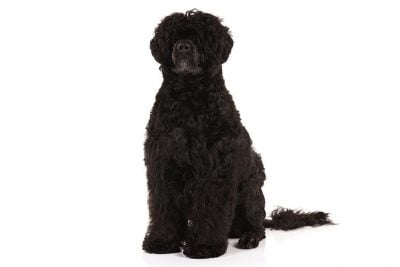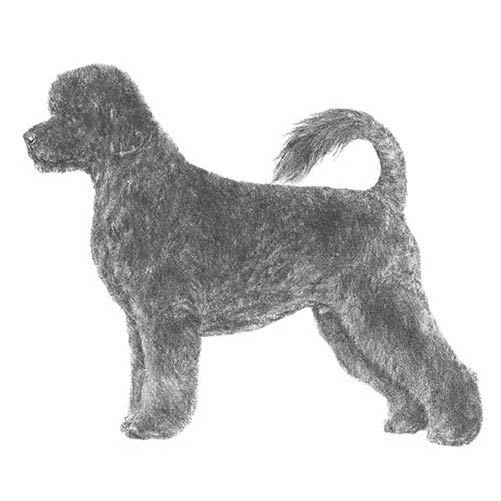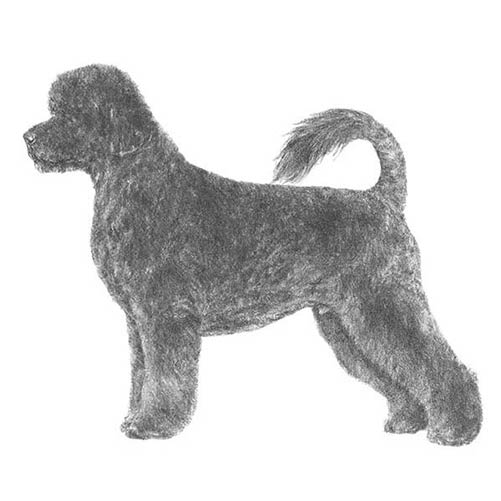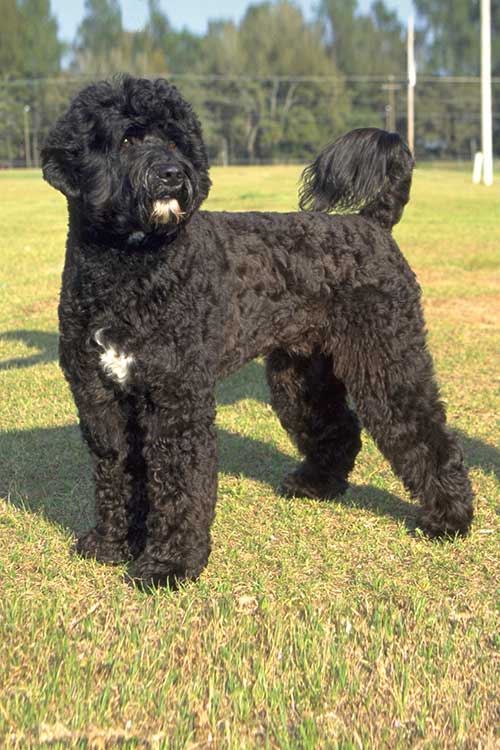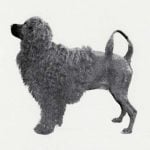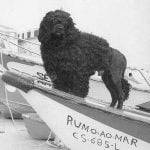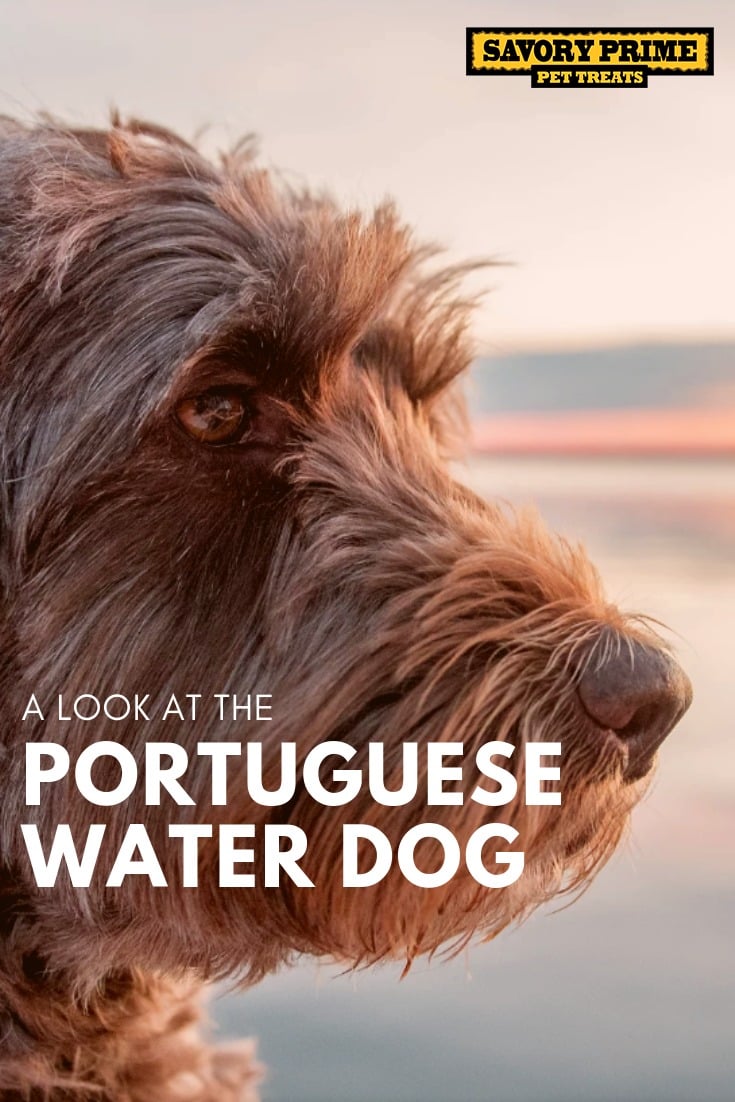The Portuguese Water Dog is super-smart and very “biddable”—meaning he’s easy to train and eager to please. The Portie can be groomed in two styles: The retriever clip (the entire coat is clipped to one inch in length, with the tail tip at full length) or the more check-me-out lion clip, where the coat on the hindquarters and muzzle is clipped down to the skin.
The Breed Standard
This highly intelligent utilitarian breed is distinguished by two coat types, either curly or wavy; an impressive head of considerable breadth and well-proportioned mass; a ruggedly built, well-knit body; and a powerful, thickly based tail, carried gallantly or used purposefully as a rudder. The Portuguese Water Dog provides an indelible impression of strength, spirit, and soundness.
HEAD
An essential characteristic; distinctively large, well proportioned and with exceptional breadth of topskull. Expression – Steady, penetrating, and attentive. Eyes – Medium in size; set well apart, and a bit obliquely. Roundish and neither prominent nor sunken. Black or various tones of brown in color. Darker eyes are preferred. Eye rims fully pigmented with black edges in black, black and white, or white dogs; brown edges in brown dogs. Haws are dark and not apparent. Ears – Set well above the line of the eye. The leather is heart shaped and thin. Except for a small opening at the back, ears are held nicely against the head. Tips should not reach below the lower jaw.
BODY
Neck – Straight, short, round, and held high. Strongly muscled. No dewlap. Topline– Level, and firm. Body – Chest is broad and deep, reaching down to the elbow. Ribs are long and well-sprung to provide optimum lung capacity. Abdomen well held up in a graceful line. Back is broad and well muscled. The loin is short and meets the croup smoothly. Croup is well formed and only slightly inclined with hip bones hardly apparent. Tail – Not docked; thick at the base and tapering; set on slightly below the line of the back; should not reach below the hock. When the dog is attentive the tail is held in a ring, the front of which should not reach forward of the loin. The tail is of great help when swimming and diving.
FOREQUARTERS
Shoulders are well inclined and very strongly muscled. Upper arms are strong. Forelegs are strong and straight with long, well-muscled forearms. Carpus is heavy-boned, wider in front than at the side. Pasterns are long and strong. Dewclaws may be removed. Feet are round and rather flat. Toes neither knuckled up nor too long. Webbing between the toes is of soft skin, well covered with hair, and reaches the toe tips. Central pad is very thick, others normal. Nails held up slightly off the ground. Black, brown, white, and striped nails are allowed.
COAT
A profuse, thickly planted coat of strong, healthy hair, covering the whole body evenly, except where the forearm meets the brisket and in the groin area, where it is thinner. No undercoat, mane or ruff. There are two varieties of coat:
Curly – Compact, cylindrical curls, somewhat lusterless. The hair on the ears is sometimes wavy.
Wavy – Falling gently in waves, not curls, and with a slight sheen.
HINDQUARTERS
Powerful; well balanced with the front assembly. Legs, viewed from the rear, are parallel to each other, straight and very strongly muscled in upper and lower thighs. Buttocks are well developed. Tendons and hocks are strong. Metatarsus long, no dewclaws. Feet similar in all respects to forefeet.
 Care
Care
Nutrition
The Portuguese Water Dog should do well on a high-quality dog food, whether commercially manufactured or home-prepared with your veterinarian’s supervision and approval. Any diet should be appropriate to the dog’s age (puppy, adult, or senior). Some dogs are prone to getting overweight, so watch your dog’s calorie consumption and weight level. Treats can be an important aid in training, but giving too many can cause obesity. Learn about which human foods are safe for dogs, and which are not. Check with your vet if you have any concerns about your dog’s weight or diet. Clean, fresh water should be available at all times.
Grooming
The Portuguese Water Dog’s dense, profuse coat is hypoallergenic but requires regular and extensive grooming. The coat ranges in appearance from tight and curly to loose and wavy. It may be kept in the lion clip (where the coat on the hindquarters and muzzle is clipped to the skin) or the retriever clip (where the entire coat is clipped to one inch in length and follows the outline of the dog). Beyond regular weekly grooming, an occasional bath will keep the Portie clean and looking his best.
Exercise
An athletic, active breed, the Portuguese Water Dog requires vigorous exercise every day to keep him healthy and happy. This can come in the form of long daily walks and play sessions with his owner. This extremely versatile breed also exercises mind and body by participating in canine sports such as obedience, tracking, agility, rally, dock diving, and other activities that can be enjoyed by dog and owner. For many enthusiasts, the most special of all the training and exercise options for the Portie is water work.
Training
The Portuguese Water Dog is very intelligent and responds well to obedience training. He is demanding of attention and human contact and greets friends and family with unbridled enthusiasm. The breed often thinks independently, and a Portie may sometimes challenge his owner’s will. He requires positive training methods as well as daily mental and physical exercise. Porties can sometimes be too exuberant for families with very young children.
Health
Portuguese Water Dogs are generally healthy, and responsible breeders test their stock for health disorders and communicate with other dedicated breeders regularly, working together for breed health and preservation of the breed’s unique qualities. A Portie’s ears should be checked regularly for signs of infection, and the teeth should be brushed often, using a toothpaste designed for dogs.
History
The Portuguese Water Dog once lived all along Portugal’s coast and was used to herd fish into nets, retrieve lost tackle, and act as a messenger between ships and shore. Fishermen counted on the strong and muscular dogs to be hardworking and seaworthy. They would ride in trawlers from the warm Atlantic waters of Portugal to the freezing cold waters off the coast of Iceland. Technology eventually laid him off from his job, but Porties are still used for water rescue
Did You Know?
Sixteen people met at the home of Mr. & Mrs. Herbert Miller, who had received a pair of the breed in a rare-breed trade, in order to form the Portuguese Water Dog Club of America. The breed became an AKC breed in January 1984.
The Portuguese Water Dog once existed all along Portugal’s coast, where it was taught to herd fish into nets, to retrieve lost tackle or broken nets, and to act as a courier from ship to ship, or ship to shore.
The Portuguese Water Dog coat is profuse, non-allergenic, non-shedding, and waterproof.
When Portugal faced social upheaval in the early 20th century, Dr. Vasco Bensuade, a wealthy Portuguese shipping magnate, and dog fancier, took it upon himself to save the Portuguese Water Dog breed.
There are two “clips” or cuts that are considered acceptable on the Portuguese Water Dog: the lion clip (with a shorn rear) and the working clip (with all hair left intact).
The Portuguese Water Dog has webbed feet.
Recent Pet Posts
Blog Categories
Product categories
- Accessories (9)
- Chicken & Veggie Wraps (8)
- Grillers Jerky Tenders (4)
- Jerky Treats (10)
- Made in the USA (9)
- Non-Rawhide Treats (28)
- Beggar Bone (11)
- Bully Sticks (4)
- Butcher Bone (4)
- Cod Skin Fish Treats (3)
- Pork Skin Twists (2)
- Pressed Rawhide Bones & Rolls (16)
- Bones & Rolls (6)
- Pressed Rawhide Bulk (6)
- Twist Sticks (4)
- Savory Munchies (13)
- Supreme Bones & Rolls (48)
- American Rawhide Bulk (16)
- Rawhide Bones (14)
- Rawhide Chips (6)
- Rawhide Rolls & Sticks (12)
- Uncategorized (8)

